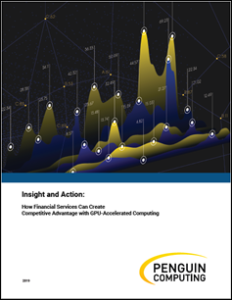
Time-to-insight is critical to banks, credit card companies, hedge funds, brokerages, insurance firms, and others who want to conduct real-time personalization for credit scoring, risk modeling and other customer-specific applications, execute smarter trades, increase profitability, eliminate fraud, reduce exposure, or implement other data-intensive projects. The financial services and insurance sector is one of the most data-intensive industries in modern business. Unfortunately, that abundance of information has hindered the extraction of business value from data.
However, improvements in technology can take data-related challenges that had, until recently, been considered impossible to overcome and transform them into immediate financial gain and competitive advantage. Previously, the financial services and insurance industries relied on costly, central processing unit (CPU) intensive infrastructure to manage data usage and analysis speed. However, with the emergence of the graphics processing unit (GPU), a new era of supercomputing has arrived, and the potential of GPU computing is still being discovered.
Change is challenging, but ever since Nathan Rothschild improved his time-to-insight by using racing pigeons to carry data from the Battle of Waterloo, the financial services sector has been on the leading-edge of technical innovation.
This new white paper from Penguin Computing highlights how financial services and insurance firms can benefit from GPU computing and spur innovation and future technological developments.
Error: Contact form not found.
All information that you supply is protected by our privacy policy. By submitting your information you agree to our Terms of Use.
* All fields required.



